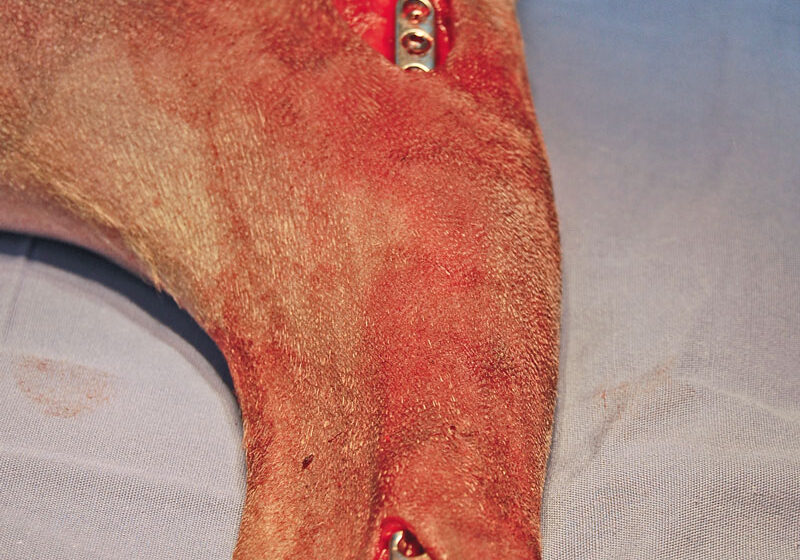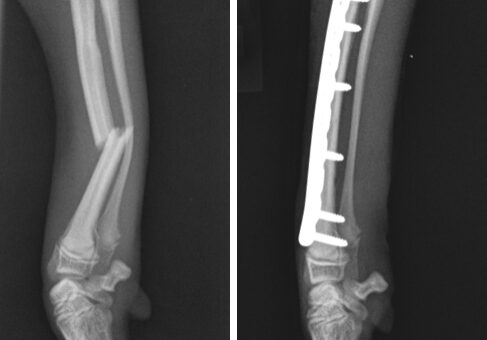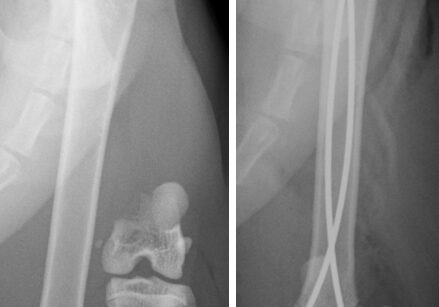Why Should I Bring my Pet to Willows for Treatment of a Fracture?
Willows is one of Europe’s leading small animal Orthopaedic referral centres treating over 1000 new patients a year. Our state-of-the-art hospital is led by internationally renowned Certified Specialists committed to providing the highest standards of care. Our team of Orthopaedic Specialists have extensive experience of successfully treating thousands of different fractures, and have published many of results in peer-reviewed journals. Our Orthopaedic Surgeons are supported by our multi-disciplinary team of Specialists across a number of disciplines including; Anaesthesia, Diagnostic Imaging and Emergency and Critical Care. Willows has a large dedicated team of Nurses and clinical support staff available 24 hours a day, every day of the year to provide the best possible care for your pet.
As in people, fractures (broken bones) occur commonly in dogs and cats. There are a huge variety of types of fractures each of which have different treatments and carry different outlooks. Although having a fracture can be very traumatic for both pet and owner, the good news is that, with the correct treatment, most fractures in dogs and cats will heal well and most animals can regain normal use of their limbs (legs).
How are Fractures Diagnosed?
Depending on the type of fracture, X-rays or a CT scan are performed to assess the broken bone and plan the treatment. Many fractures occur as a result of significant trauma, such as being hit by a car, and for these patients it is important that any additional life-threatening injuries are recognised and managed promptly.
Investigations, such as X-rays, ultrasonography and blood tests, may be performed to assess for blood loss and to detect possible chest, abdominal or spinal damage.

Fig 1: Pelvic fracture in a Labrador repaired with a bone plate and screws

Fig 2: Multiple fractures of the femur in a Spaniel repaired with a plate, screws and pins

Fig 3: Fracture of the end of the femur in a puppy repaired with two pins
What Treatment Options are Available for a Fracture?
Some fractures, especially in very young animals, can be treated using fibreglass casts. Unlike humans, dogs and cats cannot be relied on to rest the limb properly, and any bandaging has the potential to cause serious complications. As a result, most animals are best treated with an operation in which the broken bones are re-aligned and stabilised. Options for stabilising the bones include bone plates and screws, pins that are placed inside the bone, or external frames that are connected to the bone using pins going through the skin. Some fractures are relatively straightforward to manage and others are very complex, necessitating considerable orthopaedic instrumentation, implants and expertise.
In addition to traditional surgery, many fractures can benefit from minimally invasive fracture surgery to repair a fracture with the use of small surgical incisions to help preserve the tissues around the damaged bone. Minimally invasive surgery can in some cases enable a faster recovery and healing time enabling pets to return to normal activities sooner. Fractures that can be treated with minimally invasive surgery include:
- Separation between the pelvis and the spine,
- Fractures close to joints
- Long bone fractures i.e. the femur, tibia and forearm.
Depending on the type of fracture, repair may involve the placement of pins, screws, interlocking nails, or bone plates.
What can I Expect if my Pet is Treated for a Fracture?
The aftercare for a pet with a broken bone is very variable and depends on the type of fracture, the type of operation that has been performed and the nature of the patient.
Most pets can be allowed to exercise almost immediately following surgery, although it is important that unrestricted activity such as running or jumping is avoided. Some dogs and cats need to be restricted to a pen or a small room at times when unsupervised. Physiotherapy and hydrotherapy may be recommended as part of the rehabilitation programme. In most cases fracture patients will be re-examined six to eight weeks after surgery. Once an X-ray has shown the broken bone has healed, normal activity can usually be resumed.
Despite best efforts, any fracture surgery can carry a risk of problems and complications. These can include infection, poor bone healing and implant breakage. Fortunately, in experienced hands these complications are uncommon, and the vast majority of pets will have an uneventful recovery. Fractures involving joints can lead to osteoarthritis which may require long term management, although in many animals this does not cause any significant problems. All aspects of a pet’s care, including the risk of complications, will be discussed in detail during the initial consultation with a Specialist Orthopaedic Surgeon, before any treatment is started.
With correct planning and in the hands of experienced surgeons, the outlook for healing of most fractures is very good. The majority of animals can regain excellent use of their broken limb and can enjoy a normal quality of life.
To save this page as a PDF, click the button and make sure “Save as PDF” is selected.
Orthopaedics
Find out more
To assist owners in understanding more about Orthopaedics we have put together a range of information sheets to talk you through the some of the more common orthopaedic conditions seen and treated by our Specialists.

